As Croatia’s abundant rivers carve their paths to the Adriatic Sea, they cut through limestone mountain ranges, creating deep gorges and cascading waterfalls. It’s safe to say many of these waterfalls are some of the most breathtaking in Europe.
Head inland for a day to explore the country’s sensational national parks. As well as awe-inspiring waterfalls, you’ll enjoy a serene setting of lakes, rivers, forests, and canyons.
Here are 15 of the most beautiful waterfalls in Croatia to seek out on your next vacation to Europe.
Skradinski Buk Waterfall, Krka National Park
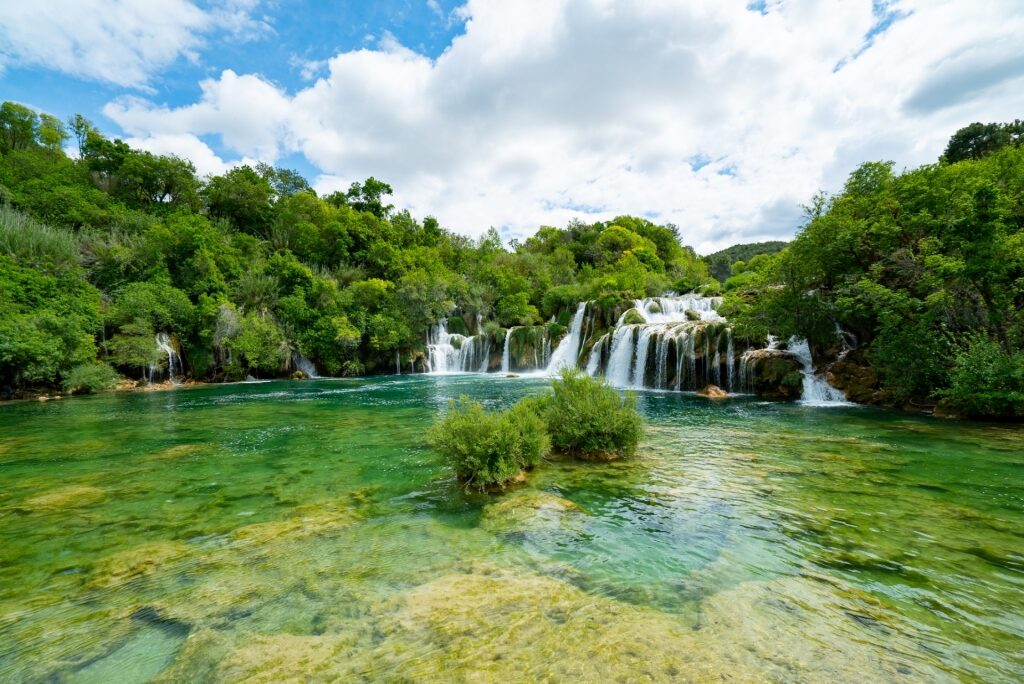
Skradinski Buk Waterfall, Krka National Park
The emerald hues of Krka National Park’s dense bush mirror the shimmering Krka and Čikola rivers. This is the location of the magnificent Skradinski Buk waterfall, one of the most beautiful places in Croatia.
This bewitching waterfall, the seventh and last barrier on the Krka River as it makes its way to the sea, is made up of 17 cascades. At its widest, Skradinski Buk is 1,300 feet and tumbles over a 150-foot shelf of natural tufa rock, surrounded by streams, pools, and thriving mossy vegetation.
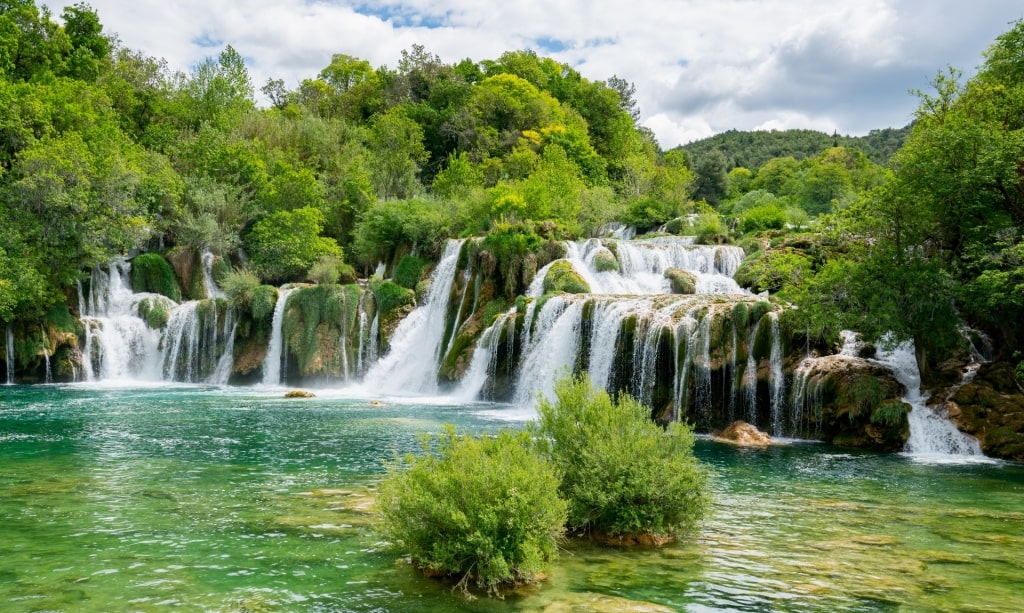
Skradinski Buk Waterfall, Krka National Park
Walk the mile-long circuit around Skradinski Buk to marvel at the waterfall from every angle. There are educational signs dotted along the trail to guide visitors on local wildlife, including shimmering dragonflies, coots, nightingales, and almost-camouflaged green frogs.
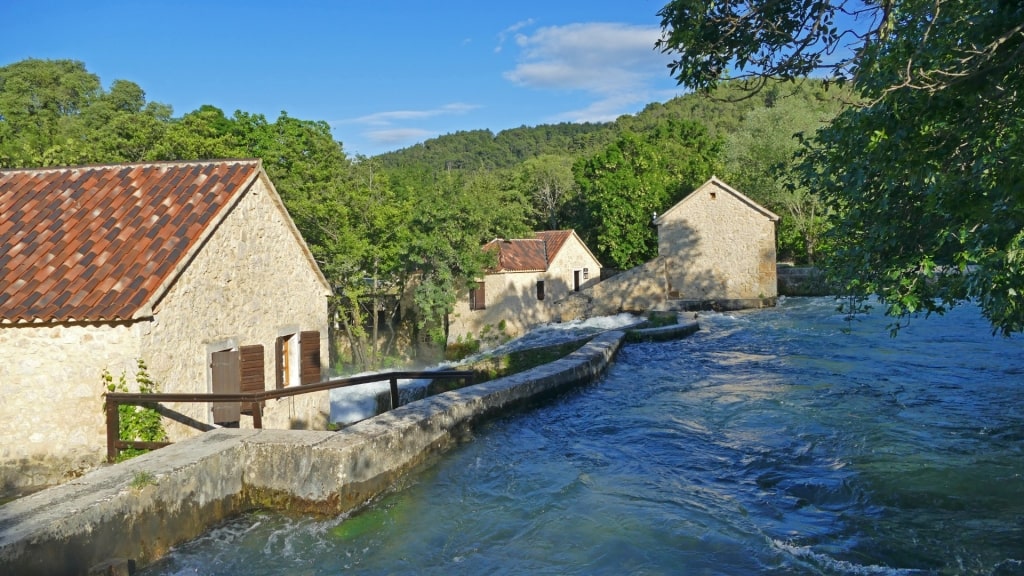
Watermills
Skradinski Buk’s hard-working watermills have been restored and transformed and are now used to display exhibitions, and as souvenir shops and restaurants. Bathroom facilities and picnic areas are also provided at Skradinski Buk.
You can’t swim here anymore; swimming has been banned by the national park to protect the environment. But you can photograph the falls from a walkway as well as from above, and around the shore of the aquamarine pool into which the water tumbles.
On a hot day, stop for ice cream at one of the cafés at the base of the falls and find a rock to sit on in the woods, where you can cool your feet in one of the rushing streams.
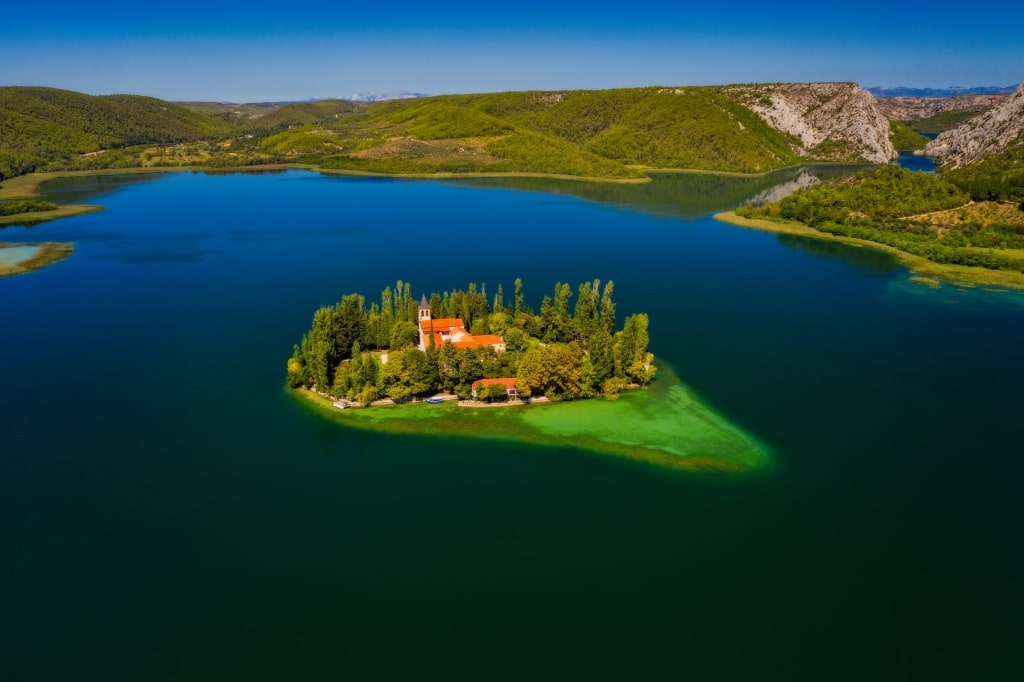
Visovac Island
Visitors here could also experience the waterfall on a boat ride from nearby Skradin. Extend your journey to Visovac Island in the middle of Visovac Lake.
Central to the small island is the centuries-old Franciscan Monastery of Our Lady of Mercy and the Church of Our Lady of Visovac, surrounded by a circle of cypress trees.
Read: Romantic Places to See on a Honeymoon in Croatia
Berberov Buk, near Zadar
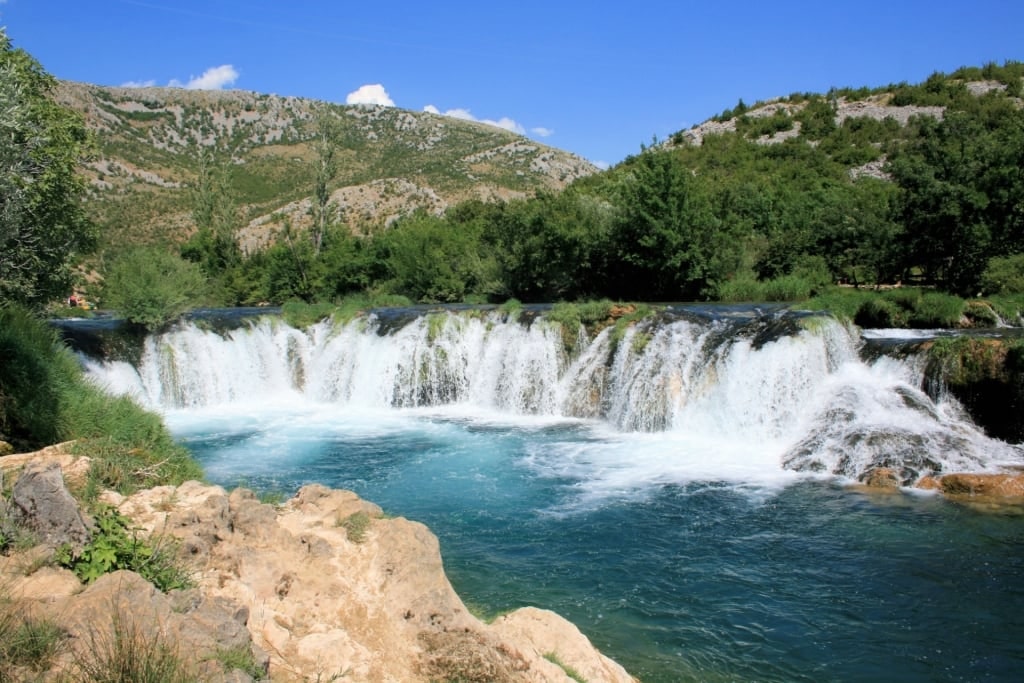
Berberov Buk, near Zadar
This marvelous waterfall on a sleepy section of the Zrmanja River lies in the center of Croatia, about an hour inland from Zadar. Water bubbles through garlands of forest-green moss at the summit of this picturesque spot.
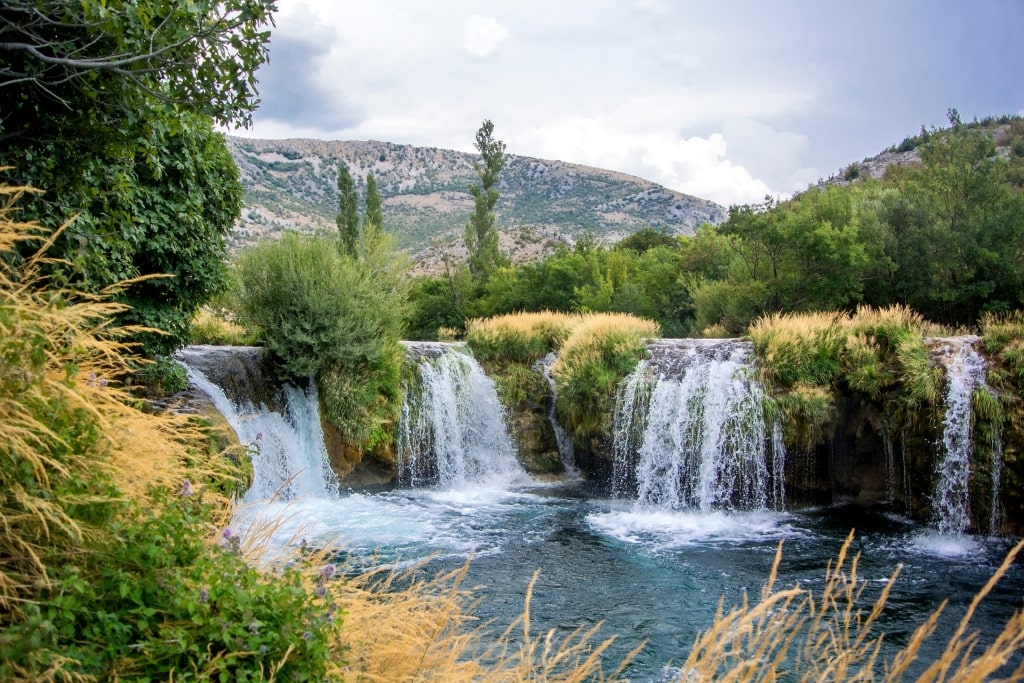
Berberov Buk, near Zadar
Dangle your feet into the clear water from the grassy banks or climb in for a cooling swim.
You could also hire a paddle board or join a guided kayaking or rafting tour to explore more of the Zrmanja.
A cluster of bars and restaurants is conveniently located facing the river at Berberov Buk. Set up to cater to the nearby campsites, they serve drinks and casual meals, such as pizza, burgers, and fries.
It’s worth carrying a small amount of local currency, as not all of the restaurants here accept credit cards.
Gubavica Waterfall, near Split
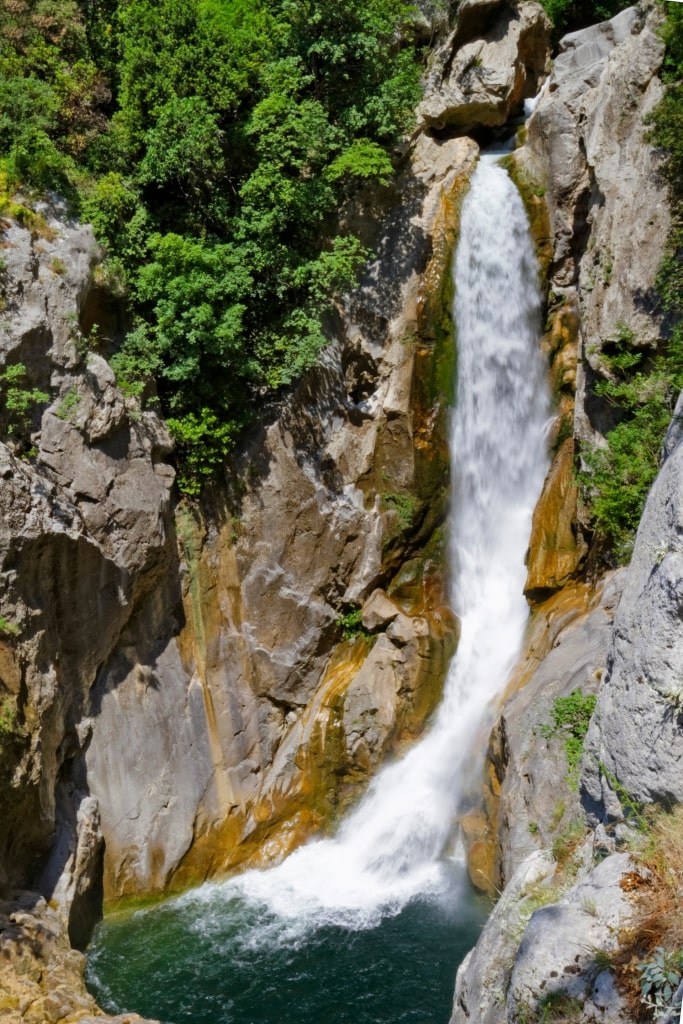
Gubavica Waterfall, near Split
Nestled in a canyon near the village of Zadvarje, two hours southeast of Split, the magnificent Gubavica is among the most beautiful waterfalls in Croatia, cascading over a towering cliff.
A popular activity for day trippers to Gubavica Waterfall is rafting and kayaking in the River Cetina.
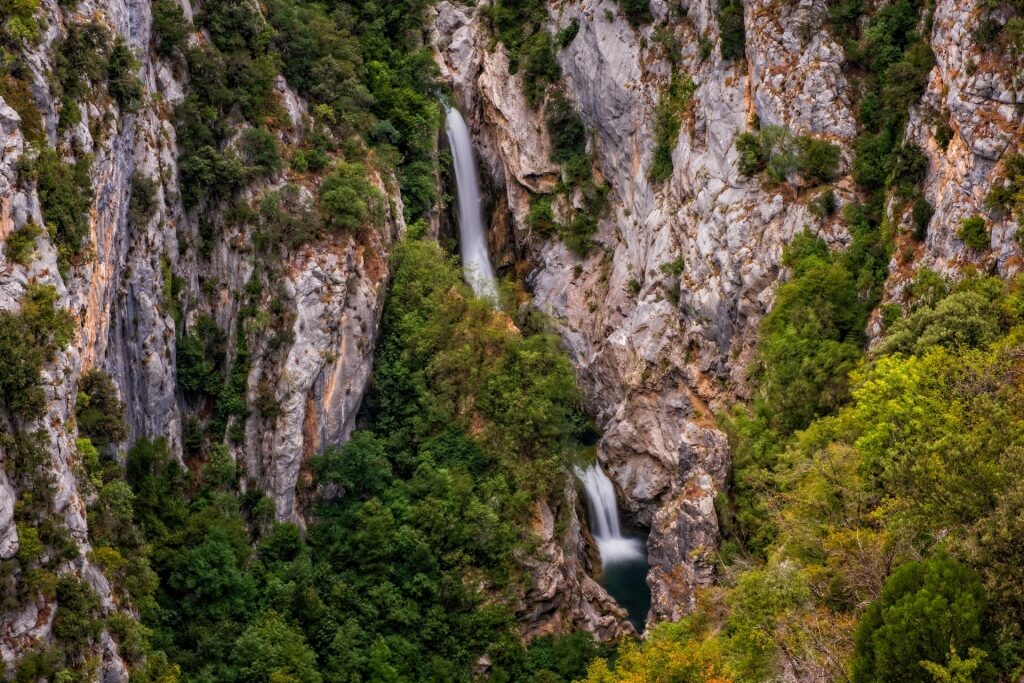
Gubavica Waterfall, near Split
If you’re hoping to experience this Croatia waterfall from a unique and spine-tingling perspective, you could also try canyoning with a local guide. This adrenaline-fueled activity sees travelers hike to the river before sliding down rapids and swimming in the waterfall’s tranquil pool.
Canyoning is one of the best ways to feel Gubavica’s soothing spray as the water plummets 164 feet down the rock face.
Go prepared with swimwear and a towel. You’ll find a handful of restaurants and convenience stores that spill out onto the main street of Zadvarje, a short walk from Gubavica.
Read: Best Things to Do in Split
Roški Waterfall, Krka National Park

Roški Waterfall, Krka National Park
Roughly one-hour southeast of Zadar, Roški is another glorious waterfall within Krka National Park.
Lying on the Krka River, Roški is made up of a 74-foot main drop, surrounded by a series of tranquil backwaters and shorter cascades.
Trace the short nature hike around the waterfall. A series of restored water mills can be observed on the waterfall’s left bank.

Roški Waterfall, Krka National Park
If you’re keen to enjoy a dip, look for the marked swimming areas downstream of the falls. There are also three rustic restaurants near the waterfall.
To the north of Roški Waterfall—on the Stinice–Roški slap hiking trail, one of the best hikes in Europe—is Oziđana pećina, a cave tucked into the left bank of the Krka River.
Discover this prehistoric cave, linked to the waterfall by 517 wooden steps, where archaeologists have traced evidence of human life back thousands of years. The remains of ceramic dishes, human skeletons, and stone artifacts have been uncovered at the site.
A boat service offers tours south to Visovac Island and north to the 14th-century Krka Monastery. It’s worth extending your visit to include this Serbian Orthodox monastery, featuring Romanesque, Byzantine, and Mediterranean architecture, and Roman catacombs beneath a section of the church.
Krupa Waterfall, near Zadar
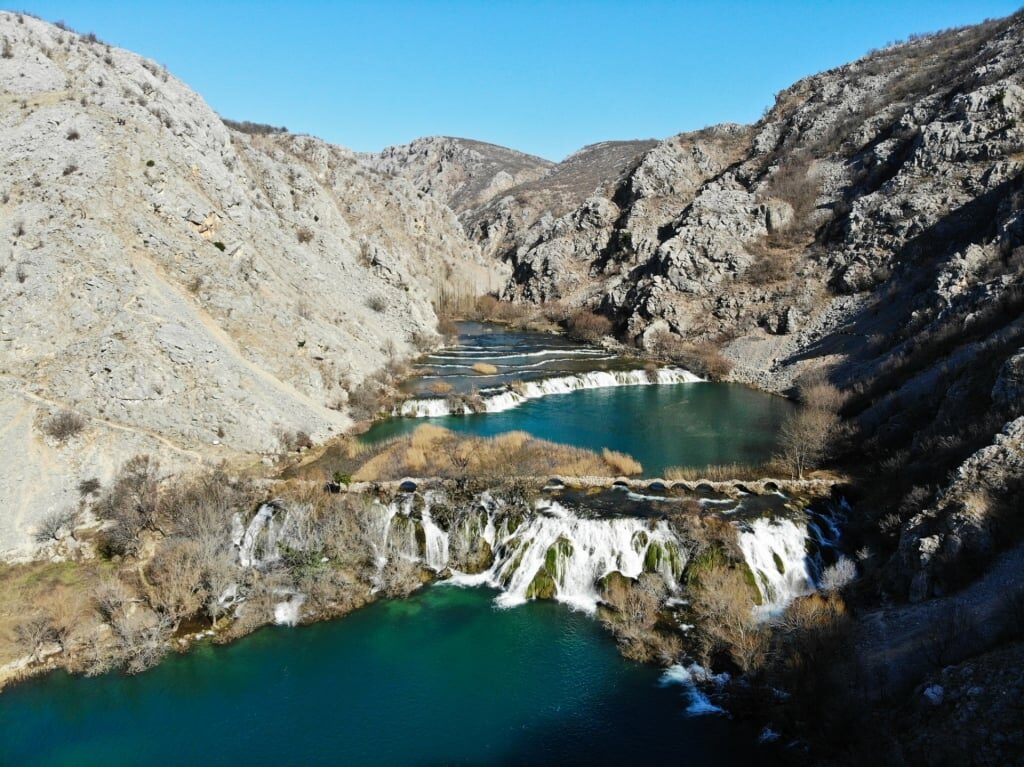
Krupa Waterfall, near Zadar
Chiseled into a vast canyon on a photogenic bend of the Krupa River, a short tributary of the Zrmanja River, Krupa Waterfall lies next to the centuries-old Kuda’s Bridge.
Travelers can reach Krupa, one of the most peaceful waterfalls in Croatia, via a 60-minute drive from Zadar, followed by a short hike. Should you decide to rent a car, there’s a parking lot in Golubić on the north side of the river.
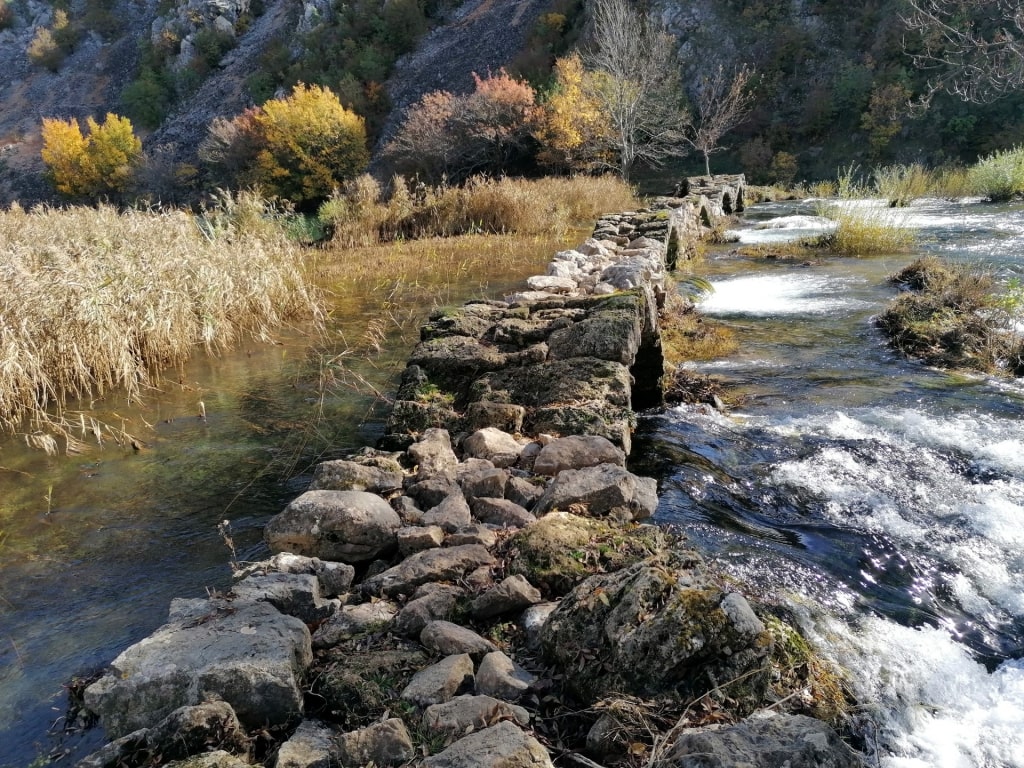
Krupa Waterfall, near Zadar
Cross the ancient 12-arched bridge and rest on the side of the limestone gorge to absorb the soothing murmur of the low-lying falls.
After, you could continue your journey via a snaking 10-minute drive to Krupa Orthodox Monastery.
Built in 1317 near the spring of the Krupa River, Krupa Monastery is the oldest Orthodox monastery in Croatia. Wander among the pine, olive, and palm trees that surround the monastery and admire the beautiful domed frescoes inside.
The Great Waterfall, Plitvice Lakes National Park
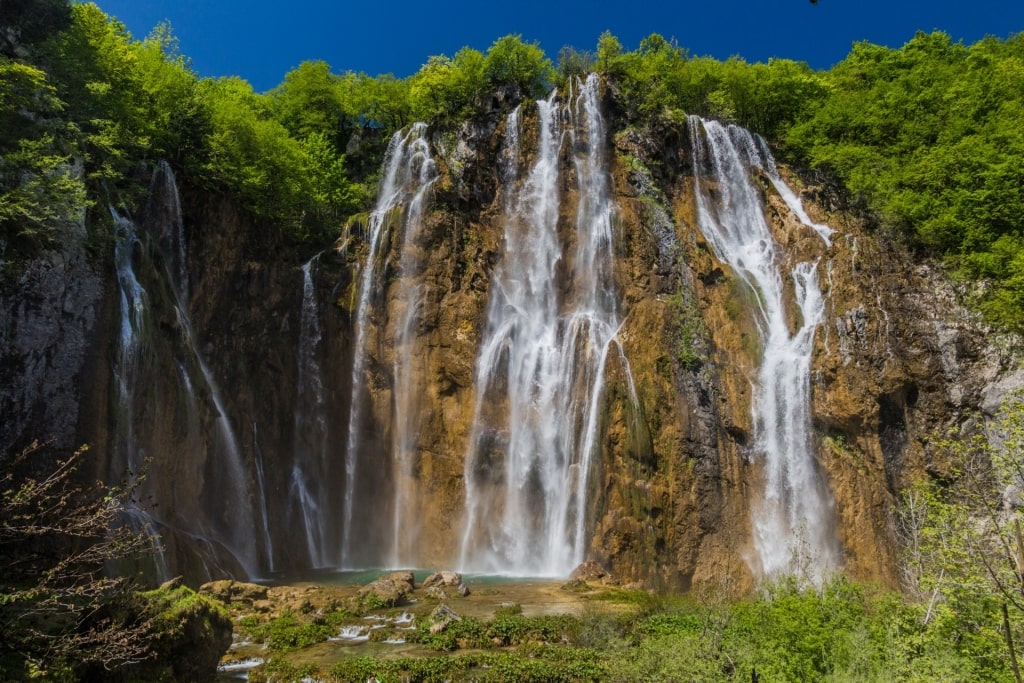
The Great Waterfall, Plitvice Lakes National Park
The Great Waterfall, also known as Veliki Slap, cascades 256 feet into Plitvice Lakes National Park, a sublime UNESCO World Heritage Site known for its 16 jade-green pools.
Fed by the Plitvice stream, which feeds into the Korana River, Veliki Slap is one of the most breathtaking waterfalls in Croatia.
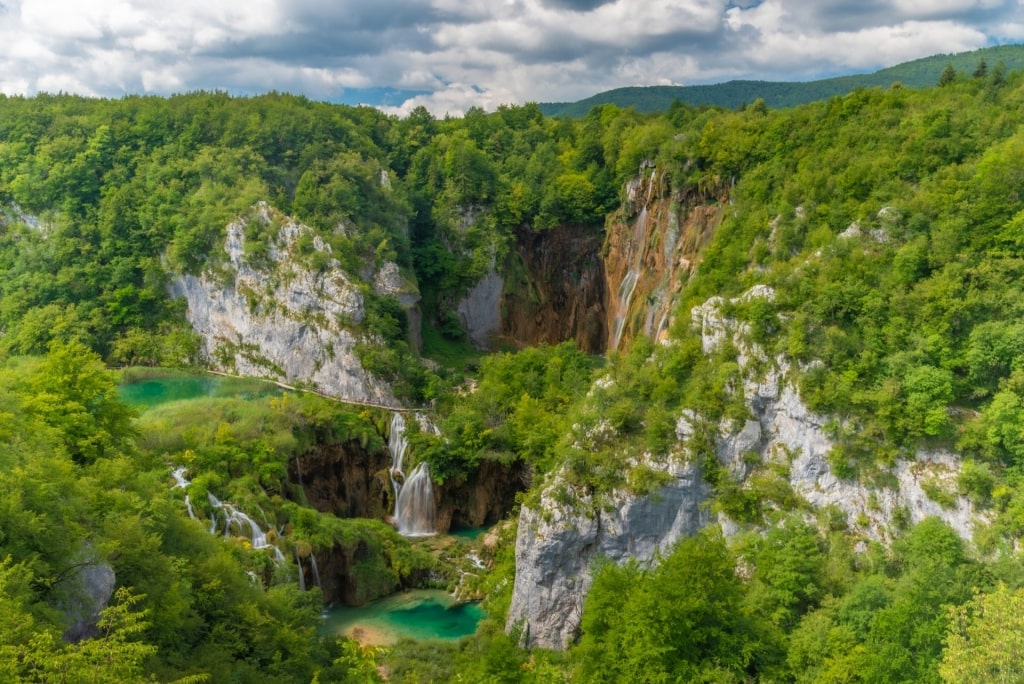
The Great Waterfall, Plitvice Lakes National Park
Starting from the entrance to Plitvice Lakes National Park, follow the signposted trail carved into the limestone landscape towards the waterfall for some of the best views.
There’s a restaurant, café, and bathrooms at the starting point, along with plenty of hiking options around the waterfall.
Krčić Waterfall, near Split and Zadar

Krčić Waterfall, near Split and Zadar
A 90-minute drive inland from the beautiful Eastern European cities of Split and Zadar, Krčić Waterfall plunges 72 feet down a precipice into the Krčić River.
Dinara, Croatia’s tallest mountain range, lies 16 miles east, its streams and pools feeding this picturesque waterfall.
During wintertime, Krčić tends to freeze over, while in summer the waterfall sometimes dries up. This leaves spring and autumn as the best seasons to visit to see the mighty Krčić Waterfall in action.
Read: Best Beaches in Split
Sastavci Waterfall, Plitvice Lakes National Park
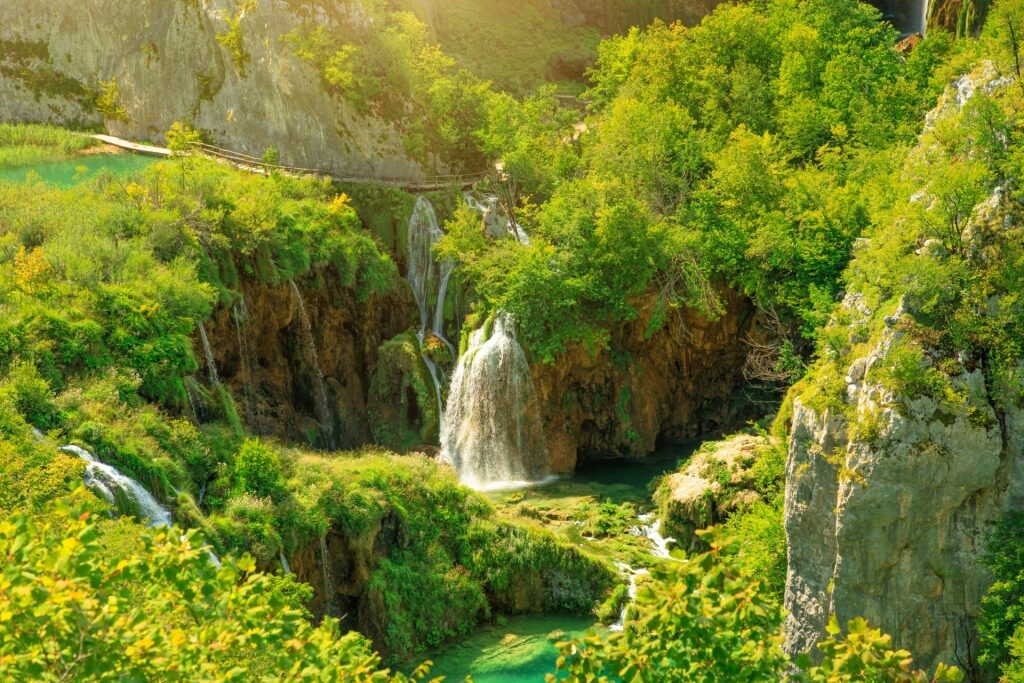
Sastavci Waterfall, Plitvice Lakes National Park
The frothing, 85-foot Sastavci is one of the most beautiful waterfalls in Croatia, flowing from Novakovica Lake, the lowest altitude lake in Plitvice National Park.
Take the opportunity to delve into the national park’s extraordinary wildlife on a guided tour. Plitvice Lakes National Park’s dense forests are home to deer, wild boars, wolves, bears, and 168 species of birds.
You could also embark on a boat tour from the east bank of Lake Kozjak, accessed from Plitvice Lakes’ Entrance 2, towards Sastavci Waterfall.
Rastoke Waterfalls, Slunj in Central Croatia
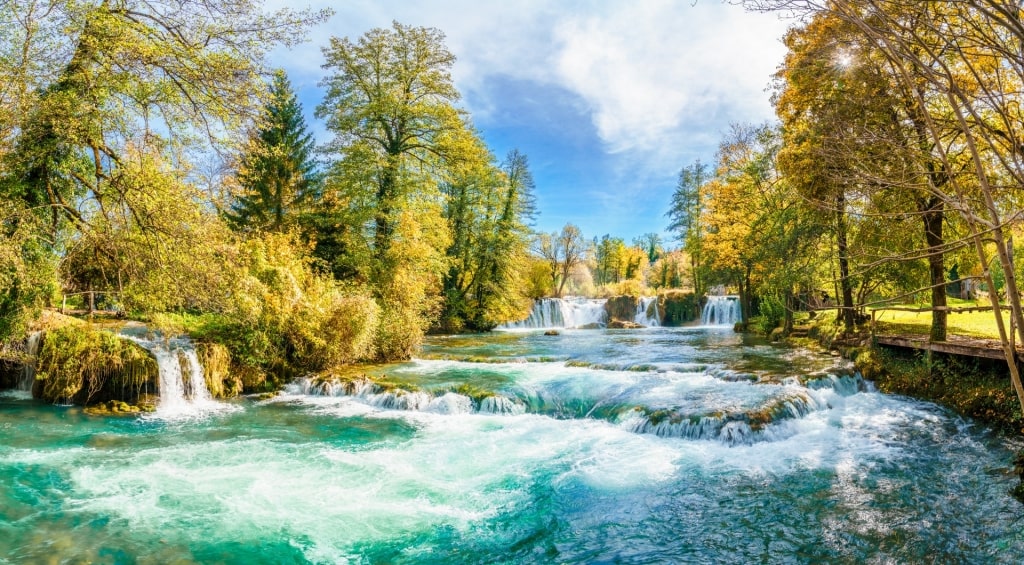
Rastoke Waterfalls in Slunj, Central Croatia
Rastoke, a rural hamlet in central Croatia two hours from Zadar, is a meeting point of the four-mile Slunjčica and Korana rivers.
The waterfalls that Croatia is known for often resemble a fairytale setting and Rastoke is no different. Where the two rivers meet, a picture-perfect series of 23 waterfalls and swirling rapids appear.
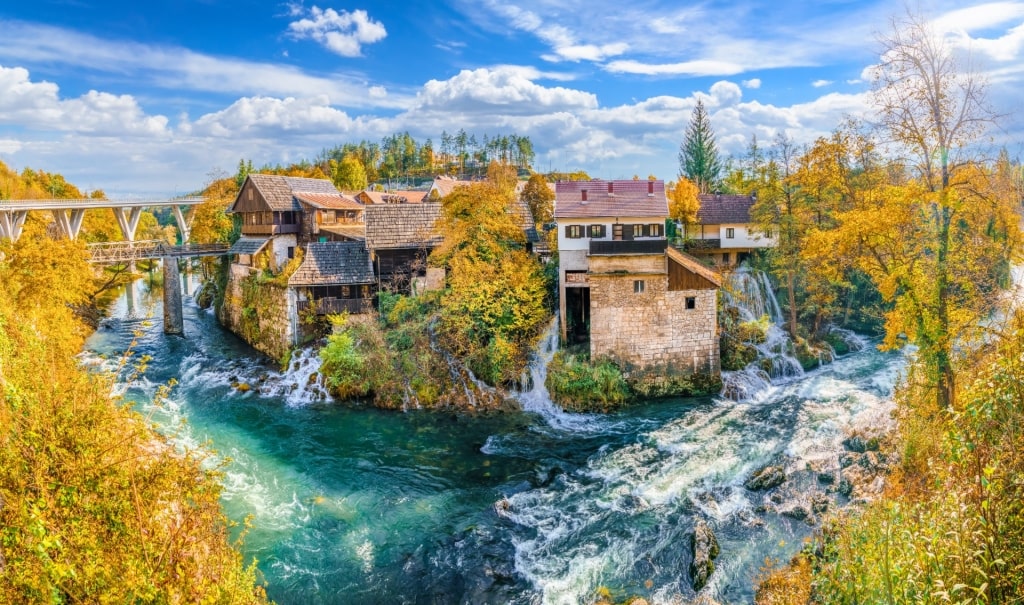
Rastoke village in Slunj, Central Croatia
Wander along the enchanting riverside to catch a glimpse of the misty falls before visiting the town’s old water mills, once used to grind corn and wheat.
There’s another reason to visit Rastoke and that’s the delightful restaurant Ambar. This modern Croatian diner is set below the remains of a Napoleonic fort, once used to store wheat and ammunition.
Take a seat outside and savor authentic Croatian food like cured meats, local cheeses, freshly made bread, and delicious Croatian wines.
Galovački Buk, Plitvice Lakes National Park

Galovački Buk, Plitvice Lakes National Park
Galovački Buk is a beguiling 52-foot waterfall that splashes into Croatia’s shimmering turquoise-green Lake Gradinsko.
Located in Plitvice Lakes National Park’s Upper Lakes, Galovački Buk is fed by water from Milino and Galovac lakes.

Gradinsko Lake, Plitvice Lakes National Park
Gradinsko is one of the largest lakes in the national park, with a depth of 35 feet, covering almost 20 acres.
If you’re game for an invigorating woodland hike, opt for the route to Tupi Medveđak. This dramatic peak commands far-reaching views of several lakes, including Prošćansko, Ciginovac, Okrugljak, Galovac, Kozjak, and Gradinsko.
You may want to hike a section of the 2,848-ft mountain rather than the entire loop. Consider the south slope for the rich fauna, including a native medicinal herb, rhamnus fallax boiss.

Lynx
On a hike, look out for some of the park’s remarkable wildlife, including a variety of deer. Wildcats, lynx, wolves, and bears live in the forests here, too, although they tend to be very elusive.
Jankovića Buk, near Zadar

Jankovića Buk, near Zadar Photo by Tadam on Wikimedia Commons, licensed under CC BY-SA 3.0
Jankovića Buk lies one hour inland from Zadar on the winding Zrmanja River, two miles upstream from the small town of Obrovac.
Visitors can walk to Jankovića Buk—the final waterfall on the Zrmanja before it reaches the coast—by following the riverside promenade from Obrovac.

Obrovac
The leisurely route is an effortless walk, tracing the river for about 45 minutes until reaching the waterfall.
Pack a picnic, which you can assemble from grocery stores in either Zadar or Obrovac, and enjoy it when you arrive at Jankovića Buk, by the remains of the old watermills that surround the waterfall.
Milka Trnina Waterfall, Plitvice Lakes National Park
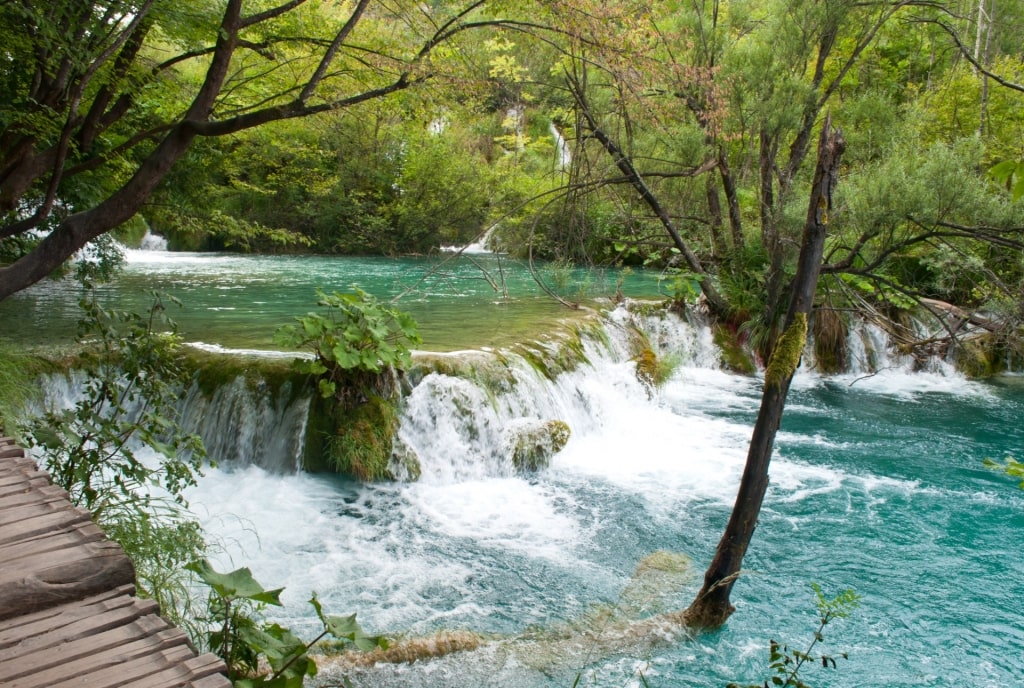
Milka Trnina Waterfall, Plitvice Lakes National Park
This Croatia waterfall lies on the barrier between the glassy lakes of Milanovac and Gavanovac in Plitvice Lakes National Park.
Milka Trnina takes its name from the 19th-century Croatian opera singer, soprano Milka Trnina, who donated vast sums of money to help preserve and protect Plitvice Lakes.
Soak up the beauty of these majestic falls and enjoy a walk to discover the nearby rare species of yew trees in the moss-draped forest.
Mrežnica Waterfall, Slunj, Central Croatia

Mrežnica Waterfall in Slunj, Central Croatia
This idyllic spot near the remote village of Primislje is one of the best Croatian waterfalls if you’re hoping to enjoy a swim in the natural pool.
Lying on the Mrežnica River—a spectacular waterway that tumbles over some 90 waterfalls—Mrežnica Waterfall is flanked by a gorgeous viridescent forest.

Mrežnica Waterfall in Slunj, Central Croatia
The waterfall features a series of shallow cascades that are popular with kayakers and rafters seeking their next rush of adrenaline.
Pack a swimsuit and a towel and enjoy a revitalizing swim. Aside from deep canyons, there’s little around Mrežnica Waterfall, so pack enough supplies for a full day out.
Veliki Prštavac Waterfall, Plitvice Lakes National Park

Veliki Prštavac Waterfall, Plitvice Lakes National Park
Veliki Prštavac is not only one of Croatia’s most dramatic waterfalls, it’s the second highest in Plitvice Lakes National Park. A single-drop white chute, Veliki Prštavac pours 92 feet into Lake Galovac.

Veliki Prštavac Waterfall, Plitvice Lakes National Park
To reach the waterfall, enter Plitvice Lakes via Entrance 2 and take a boat to the southern tip of Lake Kozjak, the largest and deepest lake in the park. From here, it’s a short walk to Veliki Prštavac.
You could also walk to Veliki Prštavac by skirting the southern section of Lake Kozjak on the designated path; a jaunt that takes around 45 minutes.
Veliki Buk, Velebit Nature Park

Veliki Buk, Velebit Nature Park
This beautiful Croatia waterfall in the Zrmanja river canyon draws nature lovers and adventure-seekers for its setting within Velebit Nature Park, just over an hour’s drive from Zadar.
This verdant UNESCO Biosphere Reserve is home to a mix of sub-Mediterranean shrub, pine, beech, fir, and subalpine meadows.
Bursts of wall bellflower in brilliant mauve line the canyon during high summer, while bird species including hazel grouse, a number of owls, golden eagle, and woodpeckers dart between sky and forest.
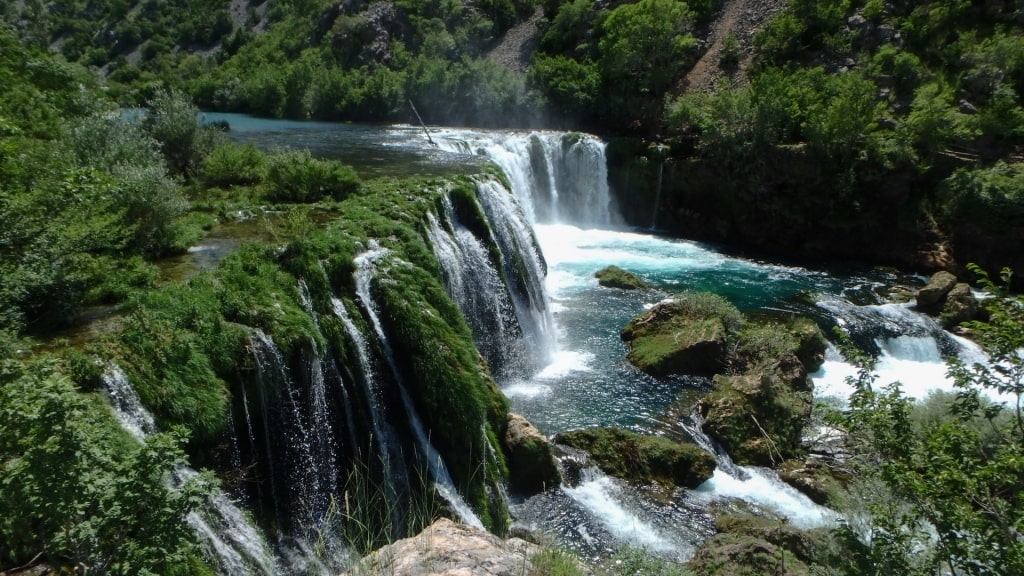
Veliki Buk, Velebit Nature Park
To capture Veliki Buk from the best angle, opt for a guided kayaking or canoeing tour on the winding Zrmanja River between the villages of Kaštel Žegarski and Muškovci. During the early season (April and May), when the water tends to be higher, the river is one of the best places to go whitewater rafting.
You’ll follow the iridescent water toward the 36-foot drop, before catching its refreshing spray. Depending on the tour you opt for, you may either be given the option to jump from Veliki Buk or, breaking from the water, bypass it via a short walk.
Carry plenty of water and snacks and apply plenty of sunscreen, as the sun can be intense out on the water.
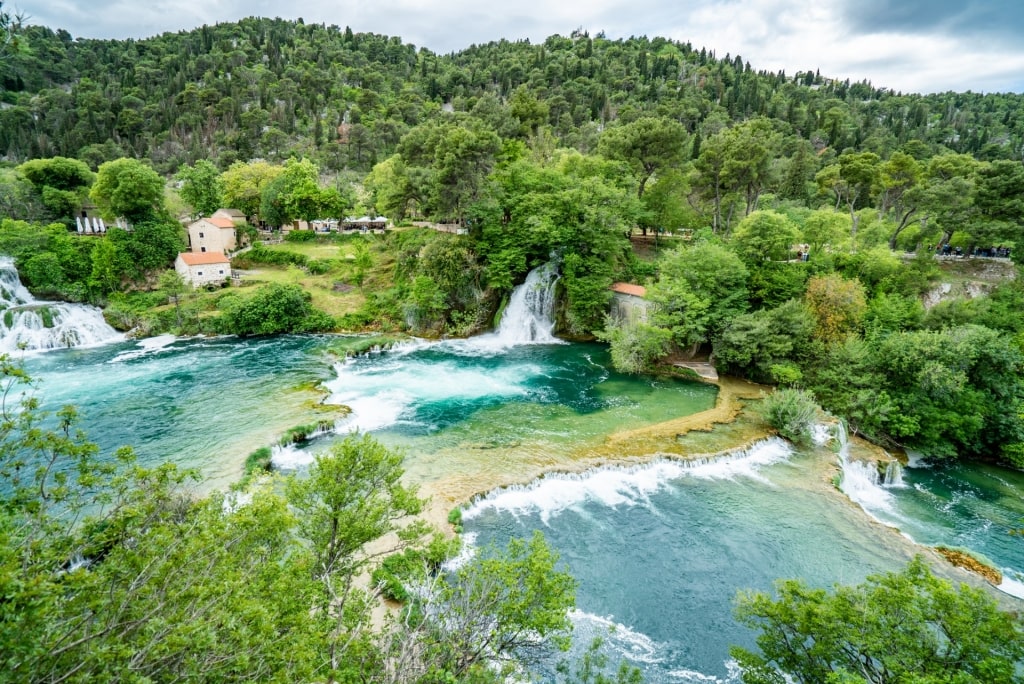
Krka National Park
Croatia’s waterfalls offer a true fairytale setting, amid the country’s lakes, mountains, and forests, as well as unbounded opportunities for hiking, kayaking, canyoning, and swimming. Explore Celebrity’s cruises to Croatia to savor the best of the Adriatic Coast.



